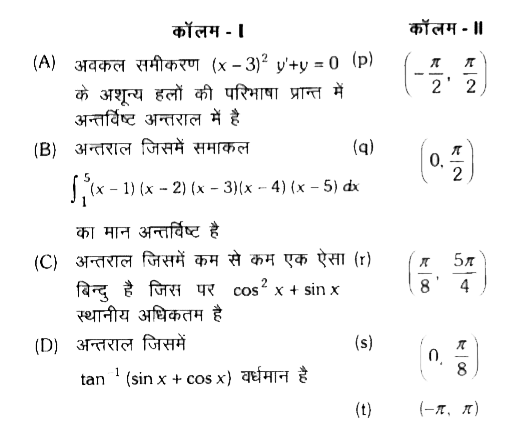कथन-1 : यदि x>0,x≠1 हो, तो
∫(logxe−(logxe)2)dx=xlogxe+C
कथन-2 : ∫ex(f(x)+f'(x))dx=exf(x)+C
तथा et=x t=lnx
कथन-1 सही है, कथन-2 सही है, कथन-1 के लिए, कथन-2 का स्पष्टीकरण सही है
कथन-1 सही है, कथन-2 सही है, कथन-1 के लिए, कथन-2 का स्पष्टीकरण सही नहीं है
कथन-1 सही है, कथन-2 गलत है
कथन-1 गलत है, कथन-2 सही है
The correct Answer is:A
Step by step video, text & image solution for कथन-1 : यदि x gt 0, x ne 1 हो, तो int (log_(x)e-(log_(x)e)^(2))dx = x log_(x)e + C कथन-2 : int e^(x) (f(x) + f'(x)) dx = e^(x) f(x) + C तथा e^(t) = x" "t = l n x by Maths experts to help you in doubts & scoring excellent marks in Class 12 exams.
Updated on:21/07/2023Topper's Solved these Questions
- अनिश्चित समाकलन Book:ERRORLESS HINDIChapter:अनिश्चित समाकलन Exercise:JEE ADVVANCED (COMPREHENSION TYPE QUESTIONS )
Explore 9 Videos
- अनिश्चित समाकलन Book:ERRORLESS HINDIChapter:अनिश्चित समाकलन Exercise:JEE ADVVANCED (INTEGER TYPE QUESTIONS )
Explore 3 Videos
- अनिश्चित समाकलन Book:ERRORLESS HINDIChapter:अनिश्चित समाकलन Exercise:JEE ADVVANCED (MORE THAN ONE CORRECT ANSWERS )
Explore 4 Videos
- PAPER(12 APRIL : SHIFT-2)Book:ERRORLESS HINDIChapter:PAPER(12 APRIL : SHIFT-2)Exercise:बहुविकल्पीय प्रश्न
Explore 30 Videos
- अवकल समीकरण Book:ERRORLESS HINDIChapter:अवकल समीकरण Exercise:JEE Advanced ( Matrix Match type questions )
Explore 3 Videos
Similar Questions
एक घात 4 का बहुपद y = f(x) अंतराल (−∞,1)∪(2,3) में वर्धमान है तथा अंतराल (1,2)∪(3,∞) में ह्रासमान है और f(0) = 1 तथा f'(0)=6 को संतुष्ट करता है। f(2) का मान ज्ञात कीजिये।
View Solutionf(x)=∫xsinx(1+xcosx.Inx+sinx)dx
यदि F(x)=xsinx=esinxInx
View Solutionयदि ∫ex−1(x2−5x+4)2xdx=AF(x−1)+BF(x−4)+C तथा F(x)=∫exxdx, हो, तो
View Solutionमाना की f(x)=5−[x−2] तथा g(x)=|x+1|,xεR यदि f(x) का अधिकतम मान α तथा g(x) का न्यूनतम मान β पर है, तो limx→−αβ(x−1)(x2−5x+6)x2−6x+8 बराबर है
View Solution
View SolutionEvaluate ∫1+x2logexx+x2logexdx
View SolutionIf ∫xlog(1+1x)dx
=f(x).loge(x+1)+g(x)logex2xLx+C , then
View SolutionIf f(x)=cos−1{1−(logex)21+(logex)2}, then f'( e )
View SolutionIf f(x)=loge(logex)logex, then f'(x) at x=e is
View Solutionनिम्नलिखित के मान ज्ञात कीजिए-
(a) ∫(logex)3xdx (b) ∫sin(logex)xdx
(c) ∫1+logexxdx (d) ∫1xcos2(logex)dx
View Solutionनिम्नलिखित समाकल का मान ज्ञात कीजिए -
(a) ∫x2logexdx (b) ∫loge(1+x2)dx
(c) ∫xlogexdx (d) ∫(logex)2dx
View Solutionसमाकलन ∫ex[f(x)+f'(x)]dx को खण्डशः विधि से निम्न प्रकार हल किया जा सकता है
I∫e2[f(x)+f'(x)]dx=∫exIf(x)IIdx+∫exf'(x)dx
=e2f(x)−∫exf'(x)dx+∫exf'(x)dx=exf(x)+C
जहाँ C का समाकलन स्थिरांक है।
तथा ∫eax[f(x)f'(x)a]dx=eAxf(x)a+C
जहाँ C का समाकलन स्थिरांक है।
∫{loge(logex)+1(logex)2}dx का मान होगा
View Solution∫elogexxdx
View SolutionI = int e^(x) { f (x) + f' (x) } dx can be found using segmented integration. As I = int e^(x) f (x) + dx + int e^(x) f' (x) dx = int e^(x) dx + e^(x) f (x) - int e^(x) f (x) dx + c = e^(x) f (x) + c And int e^(ax) { f (x) + (f' (x))/(a) }dx = a^(ax) (f(x))/(a) + c int e^(x) (tan x - log cos x ) dx = : int e^(x) ((1 + sin x)/(1 + cos x )) dx = :
View SolutionFor x∈(0,∞)if ∫ex(x−2)dxx(x2+ex)=f(x),f(1)=loge(1+e) then
View Solution